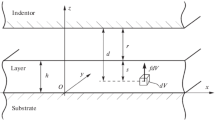Abstract
In this paper, we consider the contact of an infinitely extended plane indenter and a viscoelastic layer within the framework of the Deryagin self-consistent approach with surface (traditional formulation) and volumetric (refined formulation) application of intermolecular interaction forces. Equations that describe the time change in the contact gap for such a contact are obtained. A condition, under which an abrupt time change in the contact gap is possible, is formulated. Calculations that indicate the nonmonotonic nature of the time dependences of the contact gap and pressure in the indenter approach and retract modes are performed. It is shown that the traditional and refined problem formulations can lead to significantly different results of calculating the characteristics of the contact between the indenter and the viscoelastic layer.








Similar content being viewed by others
Change history
18 October 2022
An Erratum to this paper has been published: https://doi.org/10.3103/S0025654422320012
REFERENCES
B. Derjaguin, “Untersuchungen über die Reibung und Adhäsion, IV. Theorie des Anhaftens kleiner Teilchen,” Kolloid-Z. 69 (2), 155–164 (1934).
K. L. Johnson, K. Kendall, and A. D. Roberts, “Surface energy and the contact of elastic solids,” Proc. R. Soc. London, Ser. A 324 (1558), 301–313 (1971).
B. V. Derjaguin, V. M. Muller, and Yu. P. Toporov, “Effect of contact deformations on the adhesion of particles,’ J. Colloid Interface Sci. 53 (2), 314–326 (1975).
I. Sridhar, K. L. Johnson, and N. A. Fleck, “Adhesion mechanics of the surface force apparatus,” J. Phys. D: Appl. Phys. 30 (12), 1710–1719 (1997).
A. O. Sergici, G. G. Adams, and S. Müftü, “Adhesion in the contact of a spherical indenter with a layered elastic half-space,” J. Mech. Phys. Solids 54 (9), 1843–1861 (2006).
E. D. Reedy, “Thin-coating contact mechanics with adhesion,” J. Mater. Res. 21 (10), 2660–2668 (2006).
F. M. Borodich, B. A. Galanov, N. V. Perepelkin, and D. A. Prikazchikov, “Adhesive contact problems for a thin elastic layer: asymptotic analysis and the JKR theory,” Math. Mech. Solids 24 (5), 1405–1424 (2018).
J. A. Greenwood and K. L. Johnson, “The mechanics of adhesion of viscoelastic solids,” Philos. Mag. A 43 (3), 697–711 (1981).
I. G. Goryacheva, M. M. Gubenko, and Yu. Yu. Makhovskaya, “Sliding of a spherical indenter on a viscoelastic foundation with the forces of molecular attraction taken into account,” J. Appl. Mech. Techn. Phys. 55 (1), 81–88 (2014).
Y. Y. Lin and C. Y. Hui, “Mechanics of contact and adhesion between viscoelastic spheres: an analysis of hysteresis during loading and unloading,” J. Polym. Sci. Part B: Polym. Phys. 40, 772–793 (2002).
G. Haiat, HuyM. C. Phan, and E. Barthel, “The adhesive contact of viscoelastic spheres,” J. Mech. Phys. Solids 51 (1), 69–99 (2003).
V. M. Muller, V. S. Yushchenko, and B. V. Derjaguin, “On the influence of molecular forces on the deformation of an elastic sphere and its sticking to a rigid plane,” J. Colloid Interface Sci. 77 (1), 91–101 (1980).
P. Attard and J. L. Parker, “Deformation and adhesion of elastic bodies in contact,” Phys. Rev. A 46 (12), 7959–7971 (1992).
J. A. Greenwood, “Adhesion of elastic spheres,” Proc. R. Soc. London, Ser. A 453 (1961), 1277–1297 (1997).
I. A. Soldatenkov, “The use of the method of successive approximations to calculate an elastic contact in the presence of molecular adhesion,” J. Appl. Math. Mech. 76 (5), 597–603 (2012).
R. M. McMeeking, “A Maxwell stress for material interactions,” J. Colloid Interface Sci. 199 (2), 187–196 (1998).
R. A. Sauer and S. Li, “A contact mechanics model for quasi-continua,” Int. J. Num. Meth. Eng. 71 (8), 931–962 (2007).
L. H. He, “Stress and deformation in soft elastic bodies due to intermolecular forces,” J. Mech. Phys. Solids 61 (6), 1377–1390 (2013).
I. A. Soldatenkov, “The contact problem with the bulk application of intermolecular interaction forces (a refined formulation),” J. Appl. Math. Mech. 77 (6), 629–641 (2013).
J. T. G. Overbeek and M. J. Sparnaay, “Classical coagulation. London-van der Waals attraction between macroscopic objects,” Discuss. Faraday Soc. 18, 12–24 (1954).
J.-J. Wu, “The jump-to-contact distance in atomic force microscopy measurement,” J. Adhes. 86 (11), 1071–1085 (2010).
I. G. Kaplan, Intermolecular Interactions: Physical Picture, Computational Methods and Model Potentials (Wiley, Chichester, 2006).
J. N. Israelachvili, Intermolecular and Surface Forces (Academic, London, 2011).
R. M. Christensen, Theory of Viscoelasticity. An Introduction (Acad. Press, New York, 1971).
P. M. Ogibalov, V. A. Lomakin, and B. P. Kishkin, Mechanics of Polymers (MSU, Moscow, 1975) [in Russian].
A. A. Adamov, V. P. Matveenko, N. A. Trufanov, and I. N. Shardakov, Methods of Applied Viscoelasticity (Ural Branch RAS, Yekaterinburg, 2003) [in Russian].
I. A. Soldatenkov, “Contact with intermolecular interaction forces for a viscoelastic layer (self-consistent approach): calculation of the stress-strain state and energy dissipation,” Mech. Solids 55 (7), 159–174 (2020).
G. M. Fikhtengol’ts, Course of Differential and Integral Calculus. In 3 Vols. (Fizmatlit, Moscow, 2001), Vols. 1, 2 [in Russian].
Y. L. Chen, C. A. Helm, and J. N. Israelachvili, “Molecular mechanisms associated with adhesion and contact angle hysteresis of monolayer surfaces,” J. Phys. Chem. 95 (26), 10736–10747 (1991).
N. N. Kalitkin, Numerical Methods, 2nd ed. (BKhV-Peterburg, St. Petersburg, 2011) [in Russian].
V. V. Stepanov, Course of Differential Equations (Gos. Izd. Fiz.-Mat. Lit., Moscow, 1959) [in Russian].
Funding
This work was carried out within a state assignment (state registration no. АААА-А20-120011690132-4) and was partially supported by the Russian Foundation for Basic Research, project no. 18-08-00558.
Author information
Authors and Affiliations
Corresponding author
Additional information
Translated by A. Ivanov
About this article
Cite this article
Soldatenkov, I.A. Contact with Intermolecular Interactions for a Viscoelastic Layer (Self-Consistent Approach): Feature Analysis of the Indenter Approach/Retract Process. Mech. Solids 56, 1259–1276 (2021). https://doi.org/10.3103/S0025654421070232
Received:
Revised:
Accepted:
Published:
Issue Date:
DOI: https://doi.org/10.3103/S0025654421070232




